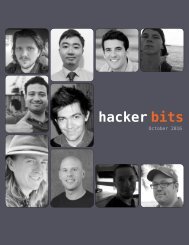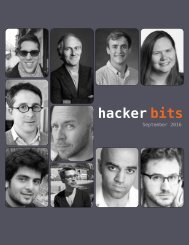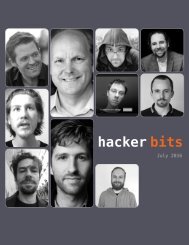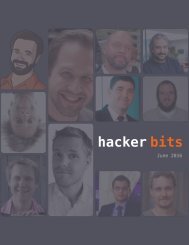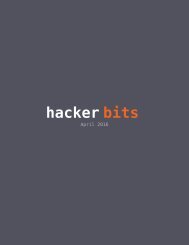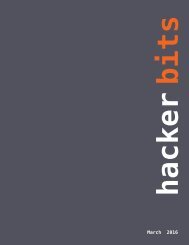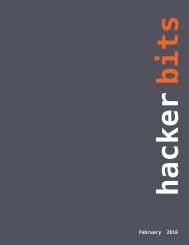Hacker Bits, August 2016
HACKER BITS is the monthly magazine that gives you the hottest technology stories crowdsourced by the readers of Hacker News. We select from the top voted stories and publish them in an easy-to-read magazine format. Get HACKER BITS delivered to your inbox every month! For more, visit https://hackerbits.com/2016-08.
HACKER BITS is the monthly magazine that gives you the hottest technology stories crowdsourced by the readers of Hacker News. We select from the top voted stories and publish them in an easy-to-read magazine format.
Get HACKER BITS delivered to your inbox every month! For more, visit https://hackerbits.com/2016-08.
Create successful ePaper yourself
Turn your PDF publications into a flip-book with our unique Google optimized e-Paper software.
def runForest(X_train, X_test, Y_train, Y_test):<br />
forest = RandomForestClassifier(n_estimators=100)<br />
forest = forest.fit(X_train, Y_train)<br />
score = forest.score(X_test, Y_test)<br />
return score<br />
forest_score = runForest(X_train, X_test, Y_train, Y_test)<br />
Figure 2: Finding scikit learn model<br />
super simple. (See figure 2)<br />
So I continued with RF to see<br />
how much I could increase the<br />
accuracy by tuning the following<br />
parameters:<br />
• Vocabulary: how many<br />
words the CountVectorizer<br />
includes in the vocabulary<br />
(currently 5K)<br />
• Gram Range: size of phrases<br />
to include in Bag Of Words<br />
(currently 1–3, meaning up<br />
until ‘3 word’-phrases)<br />
• Estimators: amount of estimators<br />
to include in Random<br />
Forest (currently 90)<br />
With these parameters<br />
tuned, the algorithm reaches an<br />
accuracy of 86.4% on the testing<br />
dataset, and is actually starting<br />
to become useful for our sales<br />
team.<br />
The road ahead<br />
However, the script is by no<br />
means finished. There are tons<br />
of ways to improve it. For example,<br />
the algorithm is likely to<br />
be biased towards the kind of<br />
descriptions we currently have<br />
in our training data. This might<br />
become a performance bottleneck<br />
when testing it on more<br />
real world data.<br />
Here are a few activities<br />
we’re considering to do in the<br />
road ahead:<br />
• Get more data (scraping,<br />
other API’s, improve data<br />
cleaning)<br />
• Test other types of data<br />
transformation (e.g. word-<br />
2vec)<br />
• Test other ML algorithms<br />
(e.g. neural nets)<br />
We’ll be pushing to GitHub<br />
regularly if you want to follow<br />
the progress. And feel free to<br />
leave a comment below if you<br />
have anything you’d like to<br />
add. •<br />
Thanks for reading! We are Xeneta — the<br />
world’s leading sea freight intelligence<br />
platform. We’re always looking for bright<br />
minds to join us, so head over to our<br />
website if you’re interested! You can<br />
follow us at both Twitter and Medium.<br />
Reprinted with permission of the original author. First appeared at medium.com/xeneta/.<br />
hacker bits<br />
53








